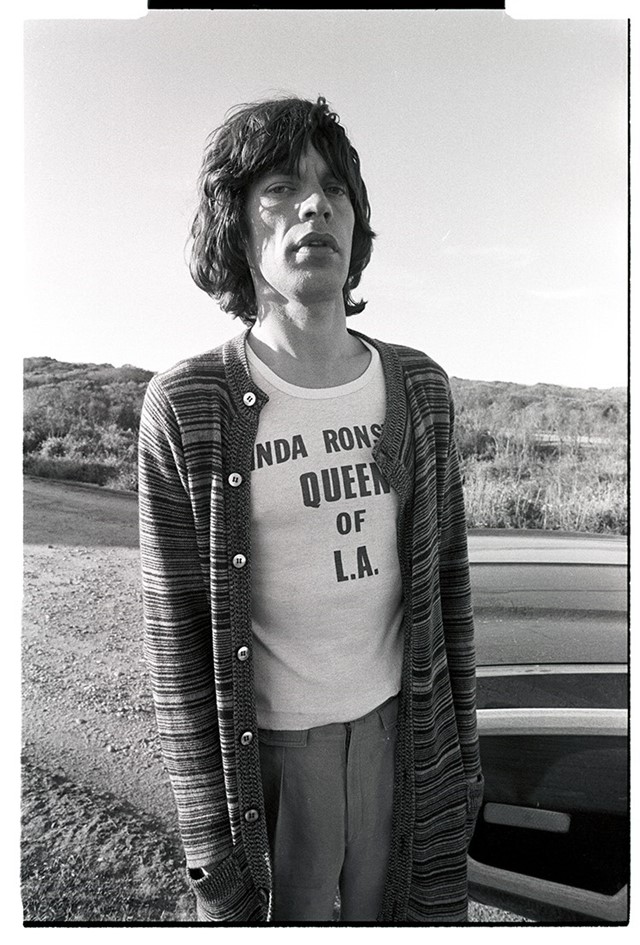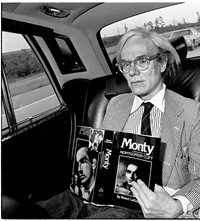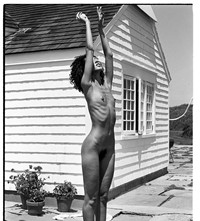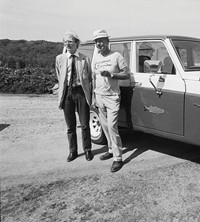Christopher Makos shares photographs of Montauk, New York and reflects on how it became a hot-spot for the cultural elite of the 1970s
- TextMiss Rosen
Back in 1971, Andy Warhol and Paul Morrissey purchased Eothen, a 12-hectare oceanfront estate on the Long Island shore for $225,000. A true East End landmark, Eothen was built in 1931 by American architect Stanford White as a fishing camp for the Church family of Montana, who used it for two weeks in September when the striped bass were running.
Comprised of four individual cottages, a three-bedroom main house, a stable, a three-car garage, and nearly a kilometer of uninterrupted coastline, Eothen boasts a fabled pedigree that continues to the present day. In 2017, Mickey Drexler, the CEO of J. Crew, sold the property to Adam Lindemann, a private investor and influential collector of contemporary art and design.
Eothen is one of the crown jewels of Montauk, a town that has evolved into a destination locale. But back in the 1970s and 80s, during the Warhol era, it was a still tiny fishing town populated by local craftsman, property maintenance people, and a smattering of wealthy people like writer Tennessee Williams and talk-show host Dick Cavett, who sought out sanctuary from the madness of New York City.
In 1973, a young American photographer named Christopher Makos first arrived on these fabled shores. “I started going out to Montauk before I knew Andy,” Makos recalls. “There wasn’t much out there. I was going out to a surfer beach called Ditch Plains with Tom Ligon, an actor friend of mine. We went out in a Cadillac, pitched a tent, and stayed there like that. I can’t believe I actually did stuff like that but I did. I was doing glamping before glamping was around.”
By the mid-70s, Makos became an integral member of the Factory, developing a friendship and camaraderie with Warhol that was mutually beneficial; Warhol taught Makos the art of business while Makos helped Warhol hone his talents behind the camera. Together they traveled the world, collaborating with some of the greatest names in music, fashion, film, art, and culture.
“It takes about three and a half hours to get all the way out to Montauk from New York, almost exactly the same time it took to go to Paris or London on the Concorde at the time, so you really could choose,” Makos reveals. “You would go to London or Paris for art, and Montauk, you would go for rest and relaxation, to chill and see the ocean. It was a very different thing.”

At a time when the Hamptons were first coming into vogue, Warhol chose to move to Montauk, while it was still a quiet outpost for surfers, free spirits, and the avant garde. Under his auspice, it became a private getaway from legends of the time, from Jackie Kennedy Onassis, Lee Radziwell, Elizabeth Taylor and Liza Minelli, to Halston, John Lennon, Mick Jagger, and Keith Richards.
“The people who visited Andy were famous but as soon as they crossed the border from the Hamptons to Montauk they just were regular people visiting other people,” Makos recalls. “When Andy was out there, it was simple and artistic, and that’s the way he liked it. People would come out to Montauk just to visit or spend a day at the beach – which in front of Andy’s house wasn’t much of a beach. It was just rocks and stuff, but it was fun to be out there. It was very family-like. It wasn’t people out there trying to be with Andy Warhol. Whoever was out there were really friends with each other.”
The reclusive layout of the expansive estate encouraged a warm, familial vibe where guests could unwind knowing there privacy was assured. To enter, you would pass the horse stable and drive in over a mile on a dirt road, then come to the one-story cottages that were very subtly and humbly designed. The main house was open floor to ceiling, with a fireplace on either end. The floors were stone and the windows were small despite the 4.5 metre ceiling.

Its simplicity and seclusion made it the ideal escape from the world. “The Rolling Stones would rent it and set it up as a studio before they went on tour – they would keep it rock & roll,” Makos remembers. “Whereas Halston would put brand new covers on the sofas and there would always be orchids, so it was much more of a fashion designer thing.”
Halson began renting Eothen in the early 80s, at the time when he was being pushed out of the fashion business and lived there until 1985. Like Warhol, he kept it very quiet and low key, preferring to have one guest at a time, such as Pat Cleveland or Martha Graham. “It was a crazy wonderful period,” Makos observes. “You have a slice of life here that doesn’t exist anymore.”















